Serendip is an independent site partnering with faculty at multiple colleges and universities around the world. Happy exploring!
Brain Behavior Institute - Session 17
|
|
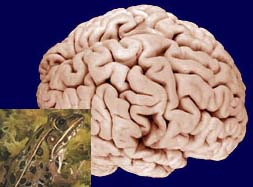 |
BRAIN AND BEHAVIOR INSTITUTE 2009 |
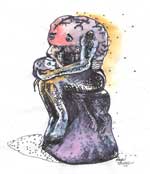 |
The cognitive unconscious, story teller, feeling, culture
From the forum
Does anyone else see faces when they look at the pipes under sinks or in the designs of urinals? Is there more matter (than in other folk) in my (part of the) brain that contains images? ... JackI have started developing a whole new lesson plan to incorporate the ambiguous figures section into the beginning of the year. Afterwards, I also have decided to take a different image each time we do a lab or group work and displaying it as a warm up board to remind students that we all have different ways of looking that can all be correct ... Kathy
ow I know that when I coach a singer, the "let's try it my way" is not necessarily being confrontational but actually opening another door, and I'm fine with that ... Verolga
As children, we make up all kinds of unique stories as to the origins of different things. As we gain more experiences, we readily change our perceptions...(monsters in the closet- make noises). As adults, we are more reticent to change our perceptions. Maybe we should be more like children ... Antoinette
| Ambiguity, "crack" in bipartite brain, gives one "agency" - Enhance agency by developing the skill of withholding judgement, conceiving alternatives - That the point of an emergent classroom? | 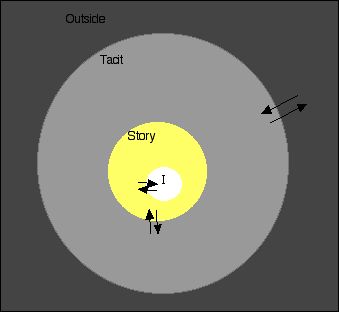 |
Interactions of the cognitive unconscious and the story teller
- Sleep/wake/dreams
- Mood, emotion, feelings
- Creativity
- Self
Learning helplessness, bullying, and ... ?
Bill Cosby on the cognitive unconscious and ...
Putting the bipartite brain together (the outside/inside loop and the unconscious/story teller loop)
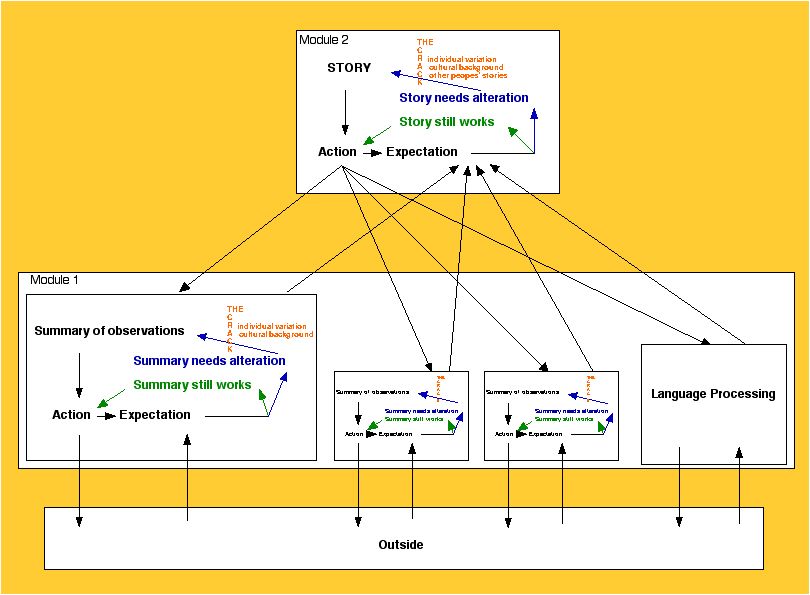
Culture as interacting brains


from The Brain and Social Organization
Interacting individual and cultural stories
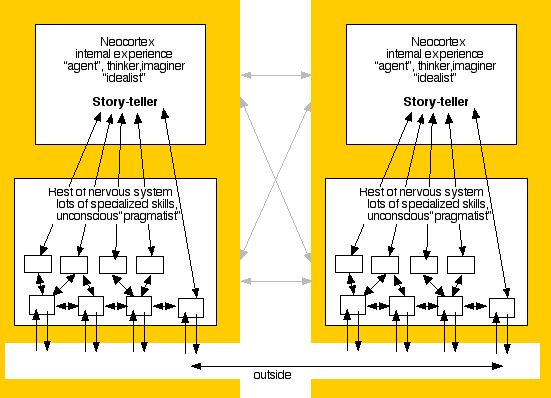 Advantages and challenges of the bipartite brain
Advantages and challenges of the bipartite brain




Comments
7/16 PM Observations
I appreciate all the boxes that opened during my co-explorers pesentations. I am excited about the potential boxes that will open as a result of the new boxes they have inspired me to open. Thank you for the infinite possibilities of exploration.
Box in Box/Brain Tricks
I found this neat optical illusion that I thought explained everything we have learned over the past few days! My brain(story teller) is still trying to communicate with my cognitive unconscious! Bill Nye
GrouPosting from: Kathy, Antoinette, Verolga, Geneva, & Lucienne
Fear of failure
1.Fear of failure changes the perspective of the “story teller” by using the word “should”
2.Fear of failure changes the story teller’s self standards
3.Fear of failure changes the story teller’s story to the is the idea of “I can” to the opposite “I can’t”
4.Fear of failure change by the story teller’s story from “I can not” to “I can” by a new set of observations and a new symphony that can be created and revised
A quote from Bill Cosby: In order to succeed, your desire for success should be greater than fear of failure.
Interaction between Cog Unconsciousness & Story Telling
The info learned today about sleep,memory etc, explains how we're organized to have corrollations between our story telling and cognitive unconsciousness. If I understand it the melodies, themes in my head are carried by my cog un and formulated in a song by my story telling mechanism. Sometimes the story telling creates major, minor moods or sometimes has no explanation at all and depresses the musical impulses and I lose the creativity at that moment. The certain musical score may or may not return. Thanks Paul.
7/16 AM Session Observations
Everybody is not always wrong. Everyone is not always right.
My interpretation of The Arc Pic (Ambiguous Figures) is that "Nothing is Impossible".
Paradoxical Sleep mirrors desynchronized awakeness.
Yes Lucy, the foods you eat directly affects the performance of your brain. :0)
Bullying
Bullying Group: Angela, Judith, Jack and Joyce
There are 3 targets (bullies, victims and observer) that can be addressed regarding the problem of bullying.
One common scenario is to convince the bullies that their behavior is not appropriate and as so must end. However if the bully's behavior is first generated in her cognitive unconscious as a response to an ‘irritation’ caused by the different behavior of the victim, then the bully will only recognize her storyteller’s generated version of why she must attack the victim until they go away and stop causing an unbalance to her accepted group culture. Her story works for her and others as the dominant members of the culture.
The victim has also generated a story as a result of cues from her cognitive unconscious that causes her to follow her own ‘true’ behavior. She has no idea why she is being attacked and is not aware of being out of balance to others. And if she does recognize why her story irritates others, she can't easily access her cognitive unconscious to change her story.
There has been some success with empowering the observers because perhaps because their cognitive unconscious is experiencing both stories and may be able to be influenced in the generation of a story that will help the victim.
The other potentially successful method could be to develop strategies that the victim might accept so as to diffuse the irritation of others (in their cognitive unconscious) and create better balance around her.
Nodding Out (during Session 17 in the AM)
WOW....Everything I say and do is always wrong and subject to looking at it differently!
I am always dreaming when I sleep. How do you explain dreams that repeat year after year- Paul..?
I think in a lot of ways I am the extreme daydreamer: More or less ignoring the world outside of me!
If we have a blind understanding that things can be both right and wrong, then what we are teaching our students may be both right and wrong too. What if the students challenge us by saying that what we say is the ways things are- are wrong?
Overheard yesterday
As I was walking to the train yesterday I overheard a man and a woman in a heated discussion. As I was passing the woman said, "You never know, they could just be telling stories."
On being skeptical of one's total experience
If individuals recognize that they have feelings but that the stories about the reason for those feelings may or may not have anything to do with what is going on in the external--then what is the purpose of reflecting on the story? They may be glimpses into what is going on in the CUC, but beyond naval gazing, do our stories serve any purpose as we interact with each other? On the one hand, if you consider that a story about a feeling may not have anything to do with your external experience then that lends power to the idea the you can't change anyone else, only your reaction to them. Still there must be something fundamentally human, some purpose, to sharing those stories about our feelings. Languages are rich with words to describe our feelings. Art, music and dance articulate feelings and are formal ways of sharing the stories that we construct about those feelings. We go to movies and read books, in part, so that our feelings will be manipulated. So that we can experience a different perspective on something. More proof that human beings are natural explorers?
Group thoughts on Learned Helplessness
Jill, Deb, Shoshona
Learned helplessness: The children who approach a problem, assignment, situation and immediately shut down and say "I can't do it." When a teacher sits with them, we discover that they actually has the skills they need and can do the work. However they continue to react in the same manner.
Our story for this behavior: The story teller is activated by an emotion. The story teller tells the story, "I can't do it", but the story is not reflective of cognitive unconscious. We can help them access their cognitive unconscious, but the next time, child responds the same way: the story hasn't changed. If you tell them their story is wrong, they might simply shut down (percieved attack on their self).
What can we do? Perhaps we can teach them to inhibit their story teller and access their cognitive unconscious. But a more effective approach seems to be to help the child tell a new story. The child needs new experiences in order to create a new story.
Could trying to associate the situation with a new emotion help as well??
Group thoughts on Learned Helplessness
Jill, Deb, Shoshona
Learned helplessness: The children who approach a problem, assignment, situation and immediately shut down and say "I can't do it." When a teacher sits with them, we discover that they actually has the skills they need and can do the work. However they continue to react in the same manner.
Our story for this behavior: The story teller is activated by an emotion. The story teller tells the story, "I can't do it", but the story is not reflective of cognitive unconscious. We can help them access their cognitive unconscious, but the next time, child responds the same way: the story hasn't changed. If you tell them their story is wrong, they might simply shut down (percieved attack on their self).
What can we do? Perhaps we can teach them to inhibit their story teller and access their cognitive unconscious. But a more effective approach seems to be to help the child tell a new story. The child needs new experiences in order to create a new story.
Could trying to associate the situation with a new emotion help as well??
Confabulation
When I was in fifth grade (or so) my Mother asked me why I did something. I responded “I though …. “ She asked me “Who is paying you to think?” I responded “You are paying all of that money to send me to a Christian school, so you are really paying me to think.” I had won that argument! My Mother just walked away from me at that point. I do not remember the preceding or the antecedents, but I remember that confabulation.
Mindfulness Meditation in the Classroom
Mindfulness in Education
The resources page may be the quickest place to start.
Post new comment